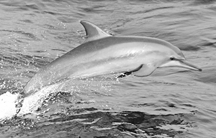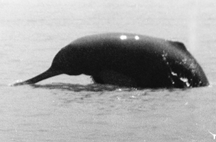Cetacean
Cetacean a group of aquatic mammals of the order Cetacea, represented by whales, dolphins and porpoises. The order is divided into two suborders: Odontoceti, having 72 extant species, which include dolphins, porpoises and most of the smaller whales; and the suborder Mysticeti, with 10 species, which include the large filter-feeding whales. All mammals first evolved on land; all are air breathing and warm-blooded (homoiothermic); but at least three separate groups have returned to the sea, and have adapted to life in water. The cetaceans (whales and dolphins) and the sirenians (manatees and the dugong) are exclusively aquatic, and have lost their hind limbs and the ability to move on land. Seals and walruses (the pinnipeds) come ashore to breed and retain their hind limbs, but move awkwardly on land. Cetaceans are thought to have evolved from the same ancestral stock as the ungulates or hoofed mammals but diverged from their common ancestor at the beginning of' the Tertiary period, some 65 million years ago. Early forms were not so well adapted for aquatic life as their living descendants, although the hind limbs appear to have become vestigial at an early stage. The sirenians are related to the proboscideans, which include the modern elephants; all early fossil forms have been found in tropical marine deposits. The pinnipeds are believed to be very closely related to carnivorous mammals such as bears and weasels, and are indeed sometimes included in the order Carnivora.
Like fishes, cetaceans have streamlined bodies to reduce drag as they move through water. The cigar or torpedo shape has proved to be most efficient and is seen in both fish and aquatic mammals. Movements are hindered by parts of the body that protrude, so external features such as limbs, ears and hair are reduced. In cetaceans and sirenians all external signs of the hind limbs have disappeared, the pelvic girdle is vestigial, and hair is virtually or totally absent. Seals and walruses need to move on land to breed and so retain hair for warmth and also have hind limbs, but these are reduced in length and are not very efficient on land. Some of these mammals can stay submerged for up to 30 minutes (although shorter dives are more common), and some for as long as two hours. They can close off the air passages and survive on low levels of oxygen by using anaerobic respiration in the muscles.
Cetaceans feed underwater, and to prevent water entering the lungs, the windpipe can be sealed off from the throat by the larynx and the epiglottis. The nostrils are generally fused to form a single opening, the blow hole, which has a valve and lies on top of the head; it is therefore the first part to emerge when a whale 'breaches' or comes to the surface after a dive. The eyes of cetaceans function equally well in and out of water, and the ears (although having no external structure) are very sensitive. Female cetaceans produce a single calf every two to three years, after a gestation period ranging from 10 to 16 months. Cetaceans are gregarious to differing extents, and often live together in groups called 'schools'. There may be some social structure within the schools, and this may vary with the seasons. Toothed whales (dolphins, porpoises and smaller whales) are found throughout the world, principally in oceans and seas, but also in some lakes and river systems. They feed on fish, cephalopods such as squid and octopus, and crustaceans. They may dive to great depths in search of prey, hunt in the mid-waters, or scan the bottom of shallow rivers and coastal waters. Most species use echolocation (similar to the system used by bats) to detect prey and surrounding obstacles. There are 10 species of baleen whales in three families. These large whales have no teeth; instead, there are sheets of horny material, called baleen or whalebone, which hang from the upper jaw.
Bangladesh has 10 species of cetaceans, of which 6 are inland and 4 are marine. In addition to cetaceans, Dugong (a sirenian or sea cow, a herbivorous mammal of the family Dugongidae, order Sirenia) has also been recorded in the coasts of Bangladesh. Of the seven inland cetaceans, four are threatened (3 critically endangered and 1 endangered); two could not be evaluated and are rated as data deficient. All the three marine mammals are globally threatened (two are endangered, one is vulnerable). The species profile of the four threatened inland cetaceans of Bangladesh is given below:

Irrawaddy Dolphin (Orcaella brevirostris) A vulnerable exclusively aquatic cetacean. Its head is globular and blunt, and does not have a beak. Its colour is uniformly slaty grey, its dorsal fin is small and sickle-shaped, has a rounded tip, and is located slightly behind the middle of the back. Its flippers are broad and triangular and their length is c. 2m. It prefers coastal waters and breathes after certain interval. It occurs in the coasts and the rivers of the Sundarbans mangrove forest in the south. Killing by fishermen as a non-target species is the major threat to their survival. They are also found in the coasts and estuaries of India, Myanmar, Thailand, Singapore, Vietnam, Laos, Kampuchea, Brunei, Malaysia, Indonesia and Australia (northern part).
Finless Porpoise (Neophocaena phocaenoides) Another endangered species, it has a streamlined body but no dorsal fin; its flippers are relatively long and taper to blunt tips; its flukes have a concave trailing edge and median notch. Its colour is uniform grey with a bluish tinge on its dorsal and lateral surfaces. Its total length is a maximum of 1.9 m. Its weight is c. 39 kg and it has at least 52 teeth. Males are larger than females. It feeds chiefly on prawns, small cephalopods and fish. It does not appear to herd in ‘schools’; on rare occasions 4 or 5 are seen together. The finless porpoise is usually solitary; pairs seem to consist of a female and a calf, and not a male and a female. A single young is born usually in October. It does not jump or somersault; on the whole it is sluggish. It occurs in the Sundarbans and in the coasts. Killing by fishermen as a non-target species is the major threat to its survival. It is also found in the Indo-Pacific region.

Ganges River Dolphin (Platanista gangetica) Once abundantly found in all major rivers, the species is now considered as endangered. Its small and rather angular body has a long (up to 45 cm) slender snout. Its colour ranges from dark to sooty black. Females are larger than males. Number of teeth is 27-32 and grow on each side of the jaw. A fleshy ridge in place of dorsal fin is located on the mid-length of the body. Pectoral flippers are triangular, broad and spatulate. Flukes are broad and wide. The total length is a maximum of 2.5 m and weight is 35-70 kg.
Though non-gregarious, it is sometimes found in small groups. The Ganges River Dolphin habitually swims on its side and rises to the surface to breathe for a few seconds; it can feed on bottom-living crustaceans and catfishes with its well-adapted jaws. In turbid water eyes (effectively blind) are probably used for finding the direction. One or rarely two young ones are born between April and July after a gestation period of 8-9 months. It occurs in all the large rivers and estuaries. Habitat destruction, change and fragmentation due to indiscriminate construction of flood control structures, and also killing by fishermen as non-target species are the major threats to its survival. [Md. Anwarul Islam]
